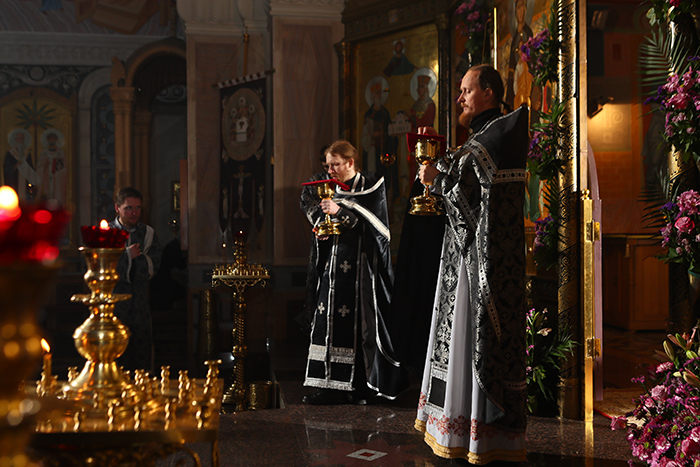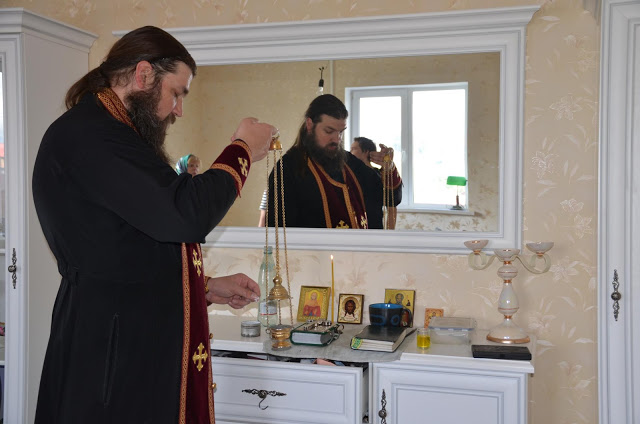
The Divine Liturgy of the Presanctified Gifts is an undeniable gem of the Lenten services of the Orthodox Church. One cannot understand the spirit of the Great Lent if one does not attend this special Liturgy at least once, especially in the statutory evening hours. What is the origin of this unique service? Is it really the product of Western liturgical life, which traces its origins back to St. Gregory the Dialogist? What is the point of such a service?
First Mentions
The earliest evidence of this service in the East dates back to the 7th century. The 615 Easter Chronicle of Constantinople states that from then on this service was to be celebrated not only in Lent, but also in other days (PG. 92. Col. 989). The Palestinian collection of The Miracles of the Holy Virgin in Chozeba by Anthony the Chozebite (†630) tells how a novice was carrying prosphoras to a monastery and read a portion of the anaphora he had heard in the Church on his way, after which the Holy Spirit descended on him and on the bread. An angel appeared to the hegumen, who was waiting for the novice, and commanded not to perform a full liturgy over the prosphora, but the rite of “Pre-Sanctified… for it is consecrated” (Houze C.). Miracula Beatae Virginis Mariae in Choziba // AnBoll. 1888. Vol. 7. P. 366-367). Likewise, Rule 52 of the Quinisext Council (691) prescribes the holding of the Presanctified Liturgy “on all the forty days of Lent, but for Saturdays and Sundays and the holy day of the Annunciation”, thus amending the instructions of the 49th and 51st Rules of the Council of Laodicea (mid-4th century), which prohibited any liturgies on the days of Lent, except Saturdays and Sundays. All these testimonies show that by the beginning of the 7th century, this order had been practiced for a long time, since it is mentioned as a common practice. At the same time, detailed descriptions of the Jerusalem worship of the fourth and fifth centuries do not mention such an order at all, so this service most likely appeared in the East in the sixth century.
The Custom of Non-Сhalcedonians?
The activity of non-Chalcedonians may be a possible reason for the rapid spread of the Liturgy of the Presanctified in the East. Their visible manifestation in the 5th-7th centuries was the refusal to receive the Eucharist from the clerics who recognized the Council of Chalcedon (451). The clergy who were in opposition to the Council of Chalcedon encouraged this by massively distributing the Holy Gifts to the lay people for home communion (Menze V.-L. Priests, Laity, and the Sacrament of the Eucharist in Sixth Century Syria). The non-Chalcedonian clerics were persecuted by the authorities and had to travel frequently, so they needed a special brief order of Liturgy, which was accompanied by easily accessible already consecrated Bread kept in the homes of the laymen. It is not surprising that Severus of Antioch (456-538), the pioneer of the non-Chalcedonian doctrine, was considered to be the inventor of the Liturgy of the Presanctified Gifts in the Jacobite milieu. The same opinion was held by the prominent liturgist Nikolai D. Uspensky, who believed that Severus was the one who ordered the “replacement of home communion with the public communion during Lent” (Uspensky. The Liturgy. 1976. P.162). It remains unclear how this order got into the divine service of the Byzantine Church, so this version is questionable.
Pastoral and Canonical Reasons
The probable reason for the establishment of the Liturgy of the Presanctified Gifts was the widespread practice of observing Lent in the 4th century. Laymen sought to attend services more often in the Lent, including on weekdays. According to the testimony of Etheria, a Roman pilgrim to Jerusalem, catechism sessions held on weekdays were particularly popular in the second half of the 4th century. Not only the catechumens, but also the faithful came to listen to them. Many wanted to partake of the Eucharist on those days, but there was a canonical ban (Canons 49 and 51 of the Council of Laodicea) on celebrating the Eucharist in the weekdays of the Lent. This is why, perhaps, there emerged the Liturgy of the Presanctified Gifts, which does not have a solemn anaphora, but allows people to partake of the Eucharist.
The Situation in the West
In the West, the Council of Laodicea was not as well-known, so by the 8th century another tradition had emerged there, namely the daily celebration of “full” liturgies on all days of Lent. This also confirms the view that the service of the Presanctified Gifts could not originate in the West, because there was no special need for it, and the communion of the Presanctified Gifts after the Ninth Hour in some Latin monasteries was preceded by a simple Our Father and was performed silently, without any chanting, unlike in the East. (Alexopoulos. The Presanctified Liturgy. 2009. P. 124-126). With regard to the attribution of the modern Liturgy of the Presanctified Gifts to St. Gregory the Great, this theory is of very recent origin (16th century); most manuscripts attribute it to other Fathers.
The spiritual importance of such Lenten liturgies cannot be overestimated. They remarkably combine the repentant mood of Lent and the joy of communion with the Risen Christ at the same time, which is of great help and comfort to those who observe Great Lent. The Lenten season is a time of spiritual combat, which is why the Fathers of the Church wisely established this spiritual respite, just as the Israelites would come across oases on their journey through the desert. Many believers report a perceptible reinforcement and encouragement from receiving the Holy Mysteries. By participating in this service, we can be part of an ancient tradition of apostolic Christianity. The time we spend waiting for the evening communion teaches us to be even more thirsty not for physical bread (see Matthew 4:4) but for the Bread of Life, for we have tasted and seen that the Lord is good (cf. Communion Verse of the Liturgy of Presanctified Gifts).



